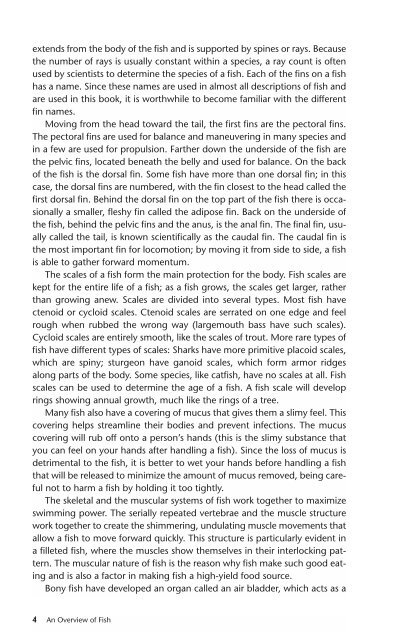Ken Schultz's Field Guide to Saltwater Fish - Macaw Pets store
Ken Schultz's Field Guide to Saltwater Fish - Macaw Pets store
Ken Schultz's Field Guide to Saltwater Fish - Macaw Pets store
Create successful ePaper yourself
Turn your PDF publications into a flip-book with our unique Google optimized e-Paper software.
extends from the body of the fish and is supported by spines or rays. Because<br />
the number of rays is usually constant within a species, a ray count is often<br />
used by scientists <strong>to</strong> determine the species of a fish. Each of the fins on a fish<br />
has a name. Since these names are used in almost all descriptions of fish and<br />
are used in this book, it is worthwhile <strong>to</strong> become familiar with the different<br />
fin names.<br />
Moving from the head <strong>to</strong>ward the tail, the first fins are the pec<strong>to</strong>ral fins.<br />
The pec<strong>to</strong>ral fins are used for balance and maneuvering in many species and<br />
in a few are used for propulsion. Farther down the underside of the fish are<br />
the pelvic fins, located beneath the belly and used for balance. On the back<br />
of the fish is the dorsal fin. Some fish have more than one dorsal fin; in this<br />
case, the dorsal fins are numbered, with the fin closest <strong>to</strong> the head called the<br />
first dorsal fin. Behind the dorsal fin on the <strong>to</strong>p part of the fish there is occasionally<br />
a smaller, fleshy fin called the adipose fin. Back on the underside of<br />
the fish, behind the pelvic fins and the anus, is the anal fin. The final fin, usually<br />
called the tail, is known scientifically as the caudal fin. The caudal fin is<br />
the most important fin for locomotion; by moving it from side <strong>to</strong> side, a fish<br />
is able <strong>to</strong> gather forward momentum.<br />
The scales of a fish form the main protection for the body. <strong>Fish</strong> scales are<br />
kept for the entire life of a fish; as a fish grows, the scales get larger, rather<br />
than growing anew. Scales are divided in<strong>to</strong> several types. Most fish have<br />
ctenoid or cycloid scales. Ctenoid scales are serrated on one edge and feel<br />
rough when rubbed the wrong way (largemouth bass have such scales).<br />
Cycloid scales are entirely smooth, like the scales of trout. More rare types of<br />
fish have different types of scales: Sharks have more primitive placoid scales,<br />
which are spiny; sturgeon have ganoid scales, which form armor ridges<br />
along parts of the body. Some species, like catfish, have no scales at all. <strong>Fish</strong><br />
scales can be used <strong>to</strong> determine the age of a fish. A fish scale will develop<br />
rings showing annual growth, much like the rings of a tree.<br />
Many fish also have a covering of mucus that gives them a slimy feel. This<br />
covering helps streamline their bodies and prevent infections. The mucus<br />
covering will rub off on<strong>to</strong> a person’s hands (this is the slimy substance that<br />
you can feel on your hands after handling a fish). Since the loss of mucus is<br />
detrimental <strong>to</strong> the fish, it is better <strong>to</strong> wet your hands before handling a fish<br />
that will be released <strong>to</strong> minimize the amount of mucus removed, being careful<br />
not <strong>to</strong> harm a fish by holding it <strong>to</strong>o tightly.<br />
The skeletal and the muscular systems of fish work <strong>to</strong>gether <strong>to</strong> maximize<br />
swimming power. The serially repeated vertebrae and the muscle structure<br />
work <strong>to</strong>gether <strong>to</strong> create the shimmering, undulating muscle movements that<br />
allow a fish <strong>to</strong> move forward quickly. This structure is particularly evident in<br />
a filleted fish, where the muscles show themselves in their interlocking pattern.<br />
The muscular nature of fish is the reason why fish make such good eating<br />
and is also a fac<strong>to</strong>r in making fish a high-yield food source.<br />
Bony fish have developed an organ called an air bladder, which acts as a<br />
4 An Overview of <strong>Fish</strong>


